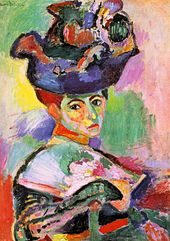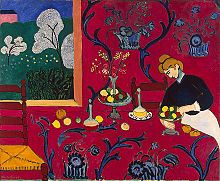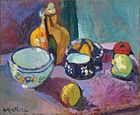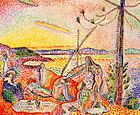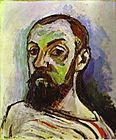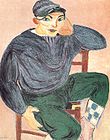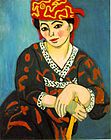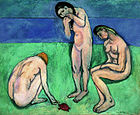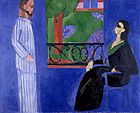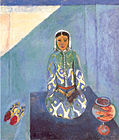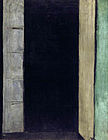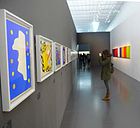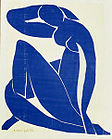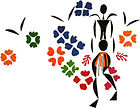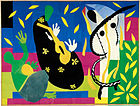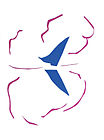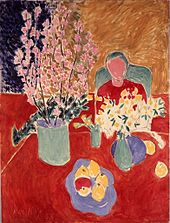- Henri Matisse
-
"Matisse" redirects here. For other uses, see Matisse (disambiguation).See also: List of works by Henri Matisse
Henri Matisse 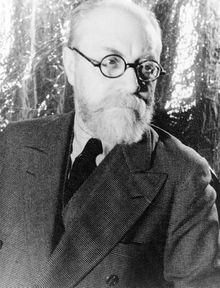
Photo of Henri Matisse by Carl Van Vechten, 1933Birth name Henri-Émile-Benoît Matisse Born 31 December 1869
Le Cateau-Cambrésis, NordDied 3 November 1954 (aged 84)
Nice, Alpes-MaritimesNationality French Field Painting, printmaking, sculpture, drawing, collage Training Académie Julian, William-Adolphe Bouguereau, Gustave Moreau Movement Fauvism, modernism, impressionism Works Woman with a Hat (Madame Matisse), 1905 in museums:
Patrons Gertrude Stein, Etta Cone, Claribel Cone, Michael and Sarah Stein, Albert C. Barnes Influenced by John Peter Russell, Paul Cézanne, Paul Gauguin, Vincent van Gogh, Paul Signac Influenced Hans Hofmann, David Hockney, Tom Wesselmann Henri Matisse (French pronunciation: [ɑ̃ʁi matis]; 31 December 1869 – 3 November 1954) was a French artist, known for his use of colour and his fluid and original draughtsmanship. He was a draughtsman, printmaker, and sculptor, but is known primarily as a painter. Matisse is commonly regarded, along with Picasso and Marcel Duchamp, as one of the three artists who helped to define the revolutionary developments in the plastic arts in the opening decades of the 20th century, responsible for significant developments in painting and sculpture.[1][2][3][4] Although he was initially labelled a Fauve (wild beast), by the 1920s he was increasingly hailed as an upholder of the classical tradition in French painting.[5] His mastery of the expressive language of colour and drawing, displayed in a body of work spanning over a half-century, won him recognition as a leading figure in modern art.[6]
Early life and education
 Woman Reading, 1894, Museum of Modern Art, Paris
Woman Reading, 1894, Museum of Modern Art, Paris
Henri-Émile-Benoît Matisse was born in Le Cateau-Cambrésis, Nord, France. He grew up in Bohain-en-Vermandois, Picardie, France, where his parents owned a flower business; he was their first son. In 1887 he went to Paris to study law, working as a court administrator in Le Cateau-Cambrésis after gaining his qualification. He first started to paint in 1889, after his mother brought him art supplies during a period of convalescence following an attack of appendicitis. He discovered "a kind of paradise" as he later described it,[7] and decided to become an artist, deeply disappointing his father.[8][9] In 1891, he returned to Paris to study art at the Académie Julian and became a student of William-Adolphe Bouguereau and Gustave Moreau. Initially he painted still-lifes and landscapes in a traditional style, at which he achieved reasonable proficiency. Matisse was influenced by the works of earlier masters such as Jean-Baptiste-Siméon Chardin, Nicolas Poussin, and Antoine Watteau, as well as by modern artists such as Édouard Manet, and by Japanese art. Chardin was one of Matisse's most admired painters; as an art student he made copies of four Chardin paintings in the Louvre.[10]
In 1896 and 1897, Matisse visited the painter John Peter Russell on the island Belle Île off the coast of Brittany. Russell introduced him to Impressionism and to the work of van Gogh, who had been a friend of Russell but was completely unknown at the time. Matisse's style changed completely, and he would later say "Russell was my teacher, and Russell explained colour theory to me."[9] In 1896 Matisse exhibited five paintings in the salon of the Société Nationale des Beaux-Arts, two of which were purchased by the state.[11]
With the model Caroline Joblau, he had a daughter, Marguerite, born in 1894. In 1898 he married Amélie Noellie Parayre; the two raised Marguerite together and had two sons, Jean (born 1899) and Pierre (born 1900). Marguerite and Amélie often served as models for Matisse.[12]
In 1898, on the advice of Camille Pissarro, he went to London to study the paintings of J. M. W. Turner and then went on a trip to Corsica.[13] Upon his return to Paris in February 1899, he worked beside Albert Marquet and met André Derain, Jean Puy,[14] and Jules Flandrin.[15] Matisse immersed himself in the work of others and went into debt from buying work from painters he admired. The work he hung and displayed in his home included a plaster bust by Rodin, a painting by Gauguin, a drawing by van Gogh, and Cézanne's Three Bathers. In Cézanne's sense of pictorial structure and colour, Matisse found his main inspiration.[14]
Many of Matisse's paintings from 1898 to 1901 make use of a Divisionist technique he adopted after reading Paul Signac's essay, "D'Eugène Delacroix au Néo-impressionisme".[13] His paintings of 1902–03, a period of material hardship for the artist, are comparatively somber and reveal a preoccupation with form. Having made his first attempt at sculpture, a copy after Antoine-Louis Barye, in 1899, he devoted much of his energy to working in clay, completing The Slave in 1903.[16]
Early paintings
-
Blue Pot and Lemon (1897), Hermitage Museum, St. Petersburg, Russia
-
Fruit and Coffeepot (1898), Hermitage Museum, St. Petersburg, Russia
-
Vase of Sunflowers (1898), Hermitage Museum, St. Petersburg, Russia
-
Crockery on a Table (1900), Hermitage Museum, St. Petersburg, Russia
Fauvism
Main article: FauvismHis first solo exhibition was at Ambroise Vollard's gallery in 1904,[14] without much success. His fondness for bright and expressive colour became more pronounced after he spent the summer of 1904 painting in St. Tropez with the neo-Impressionists Signac and Henri Edmond Cross.[13] In that year he painted the most important of his works in the neo-Impressionist style, Luxe, Calme et Volupté.[13] In 1905 he travelled southwards again to work with André Derain at Collioure. His paintings of this period are characterized by flat shapes and controlled lines, and use pointillism in a less rigorous way than before.
In 1905, Matisse and a group of artists now known as "Fauves" exhibited together in a room at the Salon d'Automne. The paintings expressed emotion with wild, often dissonant colours, without regard for the subject's natural colours. Matisse showed Open Window and Woman with the Hat at the Salon. Critic Louis Vauxcelles described the work with the phrase "Donatello au milieu des fauves!" (Donatello among the wild beasts), referring to a Renaissance-type sculpture that shared the room with them.[17] His comment was printed on 17 October 1905 in Gil Blas, a daily newspaper, and passed into popular usage.[17][18] The exhibition garnered harsh criticism—"A pot of paint has been flung in the face of the public", said the critic Camille Mauclair—but also some favourable attention.[17] When the painting that was singled out for special condemnation, Matisse's Woman with a Hat, was bought by Gertrude and Leo Stein, the embattled artist's morale improved considerably.[17]
Matisse was recognized as a leader of the Fauves, along with André Derain; the two were friendly rivals, each with his own followers. Other members were Georges Braque, Raoul Dufy and Maurice de Vlaminck. The Symbolist painter Gustave Moreau (1826–1898) was the movement's inspirational teacher; as a professor at the École des Beaux-Arts in Paris, he pushed his students to think outside of the lines of formality and to follow their visions.
In 1907 Apollinaire, commenting about Matisse in an article published in La Falange, said, "We are not here in the presence of an extravagant or an extremist undertaking: Matisse's art is eminently reasonable."[19] But Matisse's work of the time also encountered vehement criticism, and it was difficult for him to provide for his family.[9] His controversial 1907 painting Nu bleu was burned in effigy at the Armory Show in Chicago in 1913.[20]
The decline of the Fauvist movement after 1906 did nothing to affect the rise of Matisse; many of his finest works were created between 1906 and 1917, when he was an active part of the great gathering of artistic talent in Montparnasse, even though he did not quite fit in, with his conservative appearance and strict bourgeois work habits. He continued to absorb new influences: after viewing a large exhibition of Islamic art in Munich in 1910, he spent two months in Spain studying Moorish art. The effect on Matisse's art was a new boldness in the use of intense, unmodulated colour, as in L'Atelier Rouge (1911).[13]
Matisse had a long association with the Russian art collector Sergei Shchukin. He created one of his major works La Danse specially for Shchukin as part of a two painting commission, the other painting being Music, 1910. An earlier version of La Danse (1909) is in the collection of The Museum of Modern Art in New York City.
Gertrude Stein, Académie Matisse, and the Cone sisters
 Henri Matisse in Paris, August 13, 1913. Photo by Carl Van Vechten
Henri Matisse in Paris, August 13, 1913. Photo by Carl Van Vechten
Around 1904 he met Pablo Picasso, who was 12 years younger than Matisse.[9] The two became life-long friends as well as rivals and are often compared; one key difference between them is that Matisse drew and painted from nature, while Picasso was much more inclined to work from imagination. The subjects painted most frequently by both artists were women and still life, with Matisse more likely to place his figures in fully realized interiors. Matisse and Picasso were first brought together at the Paris salon of Gertrude Stein and her companion Alice B. Toklas. During the first decade of the 20th century, Americans in Paris — Gertrude Stein, her brothers Leo Stein, Michael Stein and Michael's wife Sarah — were important collectors and supporters of Matisse's paintings. In addition Gertrude Stein's two American friends from Baltimore, the Cone sisters Clarabel and Etta, became major patrons of Matisse and Picasso, collecting hundreds of their paintings. The Cone collection is now exhibited in the Baltimore Museum of Art.[21]
While numerous artists visited the Stein salon, many of these artists were not represented among the paintings on the walls at 27 Rue de Fleurus. Where Renoir, Cézanne, Matisse, and Picasso's works dominated Leo and Gertrude Stein's collection, Sarah Stein's collection emphasized Matisse.[22]
Contemporaries of Leo and Gertrude Stein, Matisse and Picasso became part of their social circle a part of the early Saturday evenings at 27 Rue de Fleurus. Gertrude attributed the beginnings of the Saturday evening salons to Matisse, remarking:
more and more frequently, people began visiting to see the Matisse paintings—and the Cézannes: "Matisse brought people, everybody brought somebody, and they came at any time and it began to be a nuisance, and it was in this way that Saturday evenings began."[23]
Among Pablo Picasso's acquaintances who also frequented the Saturday evenings were: Fernande Olivier (Picasso's mistress), Georges Braque, André Derain, the poets Max Jacob and Guillaume Apollinaire, Marie Laurencin (Apollinaire's mistress and an artist in her own right), and Henri Rousseau.[24]
His friends organized and financed the Académie Matisse in Paris, a private and non-commercial school in which Matisse instructed young artists. It operated from 1907 until 1911. Hans Purrmann and Sarah Stein were amongst several of his most loyal students.
Selected paintings: Paris, 1901–1917
-
Luxembourg Gardens (1901), Hermitage Museum, St. Petersburg, Russia
-
Dishes and Fruit (1901), Hermitage Museum, St. Petersburg, Russia
-
A Glimpse of Notre-Dame in the Late Afternoon (1902), Albright-Knox Art Gallery, Buffalo, New York
-
Luxe, Calme et Volupté, 1904, Musée National d'Art Moderne.
-
Open Window, Collioure, 1905, National Gallery of Art, Washington, DC.
-
Portrait of Madame Matisse (The green line), 1905, Statens Museum for Kunst, Copenhagen, Denmark
-
Le bonheur de vivre, 1905–6, Barnes Foundation, Merion, PA
-
Self-Portrait in a Striped T-shirt 1906, Statens Museum for Kunst, Copenhagen, Denmark
-
The Young Sailor II, 1906, Metropolitan Museum of Art, New York City
-
Vase, Bottle and Fruit (1906), Hermitage Museum, St. Petersburg, Russia
-
Madras Rouge, 1907, Barnes Foundation
-
Bathers with a Turtle, 1908, Saint Louis Art Museum, St. Louis
-
Game of Bowls, 1908, Hermitage Museum, St. Petersburg, Russia
-
The Dance (first version), 1909, The Museum of Modern Art, New York City
-
The Dance (second version), 1910, Hermitage Museum, St. Petersburg, Russia
-
Music, 1910, Hermitage Museum, St. Petersburg, Russia
-
Still Life with Geraniums, 1910, Pinakothek der Moderne, Munich, Germany
-
L'Atelier Rouge, 1911, oil on canvas, 162 x 130 cm., The Museum of Modern Art, New York City
-
The Conversation, c.1911, The Hermitage, St. Petersburg, Russia
-
Le Rifain assis, 1912–13, 200 x 160 cm. Barnes Foundation, Merion, PA
-
Zorah on the Terrace, 1912, oil on canvas, 116 x 100 cm., The Pushkin Museum of Fine Arts, Moscow, Russia
-
Window at Tangier, 1912, The Pushkin Museum of Fine Arts, Moscow
-
Woman on a High Stool, 1914, Museum of Modern Art, New York City
-
View of Notre-Dame, 1914, Museum of Modern Art
-
French Window at Collioure, 1914. Centre Georges Pompidou, Paris
-
The Yellow Curtain, 1915, Museum of Modern Art New York City
After Paris
 The Back Series, bronze, left to right: The Back I, 1908–09, The Back II, 1913, The Back III 1916, The Back IV, c. 1931, all Museum of Modern Art, New York City
The Back Series, bronze, left to right: The Back I, 1908–09, The Back II, 1913, The Back III 1916, The Back IV, c. 1931, all Museum of Modern Art, New York City
In 1917 Matisse relocated to Cimiez on the French Riviera, a suburb of the city of Nice. His work of the decade or so following this relocation shows a relaxation and a softening of his approach. This "return to order" is characteristic of much art of the post-World War I period, and can be compared with the neoclassicism of Picasso and Stravinsky, and the return to traditionalism of Derain. His orientalist odalisque paintings are characteristic of the period; while this work was popular, some contemporary critics found it shallow and decorative.
In the late 1920s Matisse notably once again engaged in active collaborations with other artists. He worked with not only Frenchmen, Dutch, Germans, and Spanish, but also a few Americans and recent American immigrants.
After 1930 a new vigor and bolder simplification appeared in his work. American art collector Albert C. Barnes convinced him to produce a large mural for the Barnes Foundation, The Dance II, which was completed in 1932. The Foundation owns several dozen other Matisse paintings.
He and his wife of 41 years separated in 1939. In 1941, he underwent surgery in which a colostomy was performed. Afterwards he started using a wheelchair, and until his death he was cared for by a Russian woman, Lydia Delektorskaya, formerly one of his models. With the aid of assistants he set about creating cut paper collages, often on a large scale, called gouaches découpés. His Blue Nudes series feature prime examples of this technique he called "painting with scissors"; they demonstrate the ability to bring his eye for colour and geometry to a new medium of utter simplicity, but with playful and delightful power.
Matisse, thoroughly unpolitical, was shocked when he heard that his daughter Marguerite, who had been active in the Résistance during the war, was tortured (almost to death) in a Rennes prison and sentenced to the Ravensbrück concentration camp.[8] (Marguerite avoided further imprisonment by escaping from the Ravensbrück-bound train, which was halted during an Allied air strike; she survived in the woods until rescued by fellow resisters.[25])
Matisse's student Rudolf Levy was killed in the Auschwitz concentration camp in 1944.[26][27]
In 1947 he published Jazz, a limited-edition book containing prints of colorful paper cut collages, accompanied by his written thoughts. In the 1940s he also worked as a graphic artist and produced black-and-white illustrations for several books and over one hundred original lithographs at the Mourlot Studios in Paris.
According to David Rockefeller, Matisse's final work was the design for a stained-glass window installed at the Union Church of Pocantico Hills near the Rockefeller estate north of New York City. "It was his final artistic creation; the maquette was on the wall of his bedroom when he died in November of 1954", Rockefeller writes. Installation was completed in 1956.[28]
The cutouts
Jazz 1947, artist's book of about one hundred prints based on paper cutouts by Henri Matisse. Tériade, a noted 20th century art publisher, arranged to have Matisse's cutouts rendered as pochoir (stencil) prints.
-
Henri Matisse, cutouts gallery in Centre Pompidou-Metz, Metz.
-
The Knife Thrower, 1947, from Jazz, print from paper collage
-
Beasts of the Sea, 1950, paper collage on canvas, collection of the National Gallery of Art, Washington, DC.
-
Black Leaf on Green Background, 1952, gouache découpée, The Menil Collection, Houston, Texas
-
Blue Nude II, 1952, gouache découpée, Pompidou Centre, Paris
-
La Négresse, 1952/1953, Lithograph after a gouache découpée, Pompidou Centre, Paris
-
The Sorrows of the King, 1952, Gouache on paper and canvas, Pompidou Centre, Paris
Legacy
 Tombstone of Henri Matisse and his wife Noellie, cemetery of the Monastère Notre Dame de Cimiez, Cimiez, France
Tombstone of Henri Matisse and his wife Noellie, cemetery of the Monastère Notre Dame de Cimiez, Cimiez, France
In 1951 Matisse finished a four-year project of designing the interior, the glass windows and the decorations of the Chapelle du Rosaire de Vence, often referred to as the Matisse Chapel. This project was the result of the close friendship between Matisse and Sister Jacques-Marie.[29] He had hired her as a nurse and model in 1941 before she became a Dominican nun and they met again in Vence and started the collaboration, a story related in her 1992 book Henri Matisse: La Chapelle de Vence and in the 2003 documentary "A Model for Matisse".[30]
He established a museum dedicated to his work in 1952, in his birthplace city, and this museum is now the third-largest collection of Matisse works in France.
Matisse died of a heart attack at the age of 84 in 1954. He is interred in the cemetery of the Monastère Notre Dame de Cimiez, near Nice.
The first painting of Matisse acquired by a public collection was Still Life with Geraniums (1910), exhibited in the Pinakothek der Moderne.[31]
The Plum Blossoms, a 1948 painting by Henri Matisse, was purchased on 8 September 2005, for the Museum of Modern Art by Henry Kravis and the new president of the museum, Marie-Josée Drouin. Estimated price was US $25 million. Previously, it had not been seen by the public since 1970.[32] In 2002, a Matisse sculpture, Reclining Nude I (Dawn), sold for US $9.2 million, a record for a sculpture by the artist.
Matisse's daughter Marguerite often aided Matisse scholars with insights about his working methods and his works. She died in 1982 while compiling a catalog of her father's work.[33]
Matisse's son, Pierre Matisse, (1900–1989) opened an important modern art gallery in New York City during the 1930s. The Pierre Matisse Gallery which was active from 1931 until 1989 represented and exhibited many European artists and a few Americans and Canadians in New York often for the first time. He exhibited Joan Miró, Marc Chagall, Alberto Giacometti, Jean Dubuffet, André Derain, Yves Tanguy, Le Corbusier, Paul Delvaux, Wifredo Lam, Jean-Paul Riopelle, Balthus, Leonora Carrington, Zao Wou Ki, Sam Francis, sculptors Theodore Roszak, Raymond Mason and Reg Butler, and several other important artists, including the work of Henri Matisse.[34][35]
Henri Matisse's grandson, Paul Matisse, is an artist and inventor living in Massachusetts. Matisse's great-granddaughter Sophie Matisse is active as an artist as of 2010. Les Heritiers Matisse functions as his official Estate. The U.S. copyright representative for Les Heritiers Matisse is the Artists Rights Society.[36]
Partial list of works
Main article: List of works by Henri MatissePortrayal in media and literature
Film dramatizations
- Veteran US actor Al Pacino is to play Henri Matisse in an upcoming film called "Masterpiece," about the pioneering French artist and his relationship with his nurse and model Monique Bourgeois.[citation needed] It will be directed by Deepa Mehta, whose previous work includes 2003's Bollywood Hollywood and Water in 2006.
Books/Essays
- Notes of a Painter,1908
- Painter's Notes on Drawing,1930.
- Jazz, 1947
- Matisse on Art, collected by Jack D. Flam, 1973. ISBN 0-7148-1518-7
Notes
- ^ "Tate Modern: Matisse Picasso". Tate.org.uk. http://www.tate.org.uk/modern/exhibitions/matissepicasso/. Retrieved 13 February 2010.
- ^ Adrian Searle (7 May 2002). "Searle, Adrian, A momentous, tremendous exhibition, The Guardian, Tuesday 7 May 2002". Guardian (UK). http://www.guardian.co.uk/culture/2002/may/07/artsfeatures. Retrieved 13 February 2010.
- ^ "Trachtman, Paul, Matisse & Picasso, Smithsonian, February 2003". Smithsonianmag.com. http://www.smithsonianmag.com/arts-culture/matisse.html. Retrieved 13 February 2010.
- ^ "Duchamp's urinal tops art survey". news.bbc.co.uk. 1 December 2004. http://news.bbc.co.uk/2/hi/entertainment/4059997.stm. Retrieved 10 December 2010.
- ^ Wattenmaker, Richard J.; Distel, Anne, et al. (1993). Great French Paintings from the Barnes Foundation. New York: Alfred A. Knopf. ISBN 0-679-40963-7. p. 272
- ^ Magdalena Dabrowski Department of Nineteenth-Century, Modern, and Contemporary Art, The Metropolitan Museum of Art Source: Henri Matisse (1869–1954) | Thematic Essay | Heilbrunn Timeline of Art History | The Metropolitan Museum of Art Retrieved 30 June 2010
- ^ Leymarie, Jean; Read, Herbert; Lieberman, William S.(1966), Henri Matisse, UCLA Art Council, p.9.
- ^ a b Bärbel Küster. "Arbeiten und auf niemanden hören." Süddeutsche Zeitung, 6 July 2007. (German)
- ^ a b c d The Unknown Matisse..., ABC Radio National, 8 June 2005
- ^ "The Unknown Matisse: A Life of Henri Matisse, the Early Years, 1869–1908", Hilary Spurling p.86 accessed online 15 July 2007
- ^ Henri and Pierre Matisse, Cosmopolis, No 2, January 1999
- ^ Marguerite Matisse Retrieved December 13, 2010
- ^ a b c d e Oxford Art Online, "Henri Matisse"
- ^ a b c Leymarie, Jean; Read, Herbert; Lieberman, William S. (1966), Henri Matisse, UCLA Art Council, p.10.
- ^ [1] on page 23 of Google Book Link
- ^ Leymarie, Jean; Read, Herbert; Lieberman, William S. (1966), Henri Matisse, UCLA Art Council, pp.19–20.
- ^ a b c d Chilver, Ian (Ed.). "Fauvism", The Oxford Dictionary of Art, Oxford University Press, 2004. Retrieved from enotes.com, 26 December 2007.
- ^ John Elderfield, The "Wild Beasts" Fauvism and Its Affinities, 1976, Museum of Modern Art, p.43, ISBN 0-87070-638-1
- ^ Picasso and Braque pioneering cubism, William Rubin, published by the Museum of Modern Art, New York, copyright 1989, ISBN 0 87070-676-4 p.348.
- ^ "Matisse, Henri." Encyclopædia Britannica. 2007. Encyclopædia Britannica Online. Retrieved 30 July 2007.
- ^ Cone Collection, Baltimore Museum of Art. Retrieved 29 July 2007.
- ^ (MoMA, 1970 at 28)
- ^ (Mellow, 1974, p. 84)
- ^ (Mellow, 1974, p. 94-95)
- ^ Kunstgeschichte im "Dritten Reich": Theorien, Methoden, Praktiken, edited by Ruth Heftrig, Olaf Peters, Barbara Maria Schellewald, Akademie Verlag, 2008, p. 429; Matisse the Master: A Life of Henri Matisse, the Conquest of Colour, 1909–1954, by Hilary Spurling, p.424.
- ^ Gilbert, Martin (2002). The Routledge Atlas of the Holocaust. Psychology Press. p. 10. ISBN 9780415281454. http://books.google.com/books?id=pYs5OSnsrHwC&printsec=frontcover&dq=The+Routledge+atlas+of+the+Holocaust&hl=en&ei=VjZYTf2UO4Sq8AaSr9GABw&sa=X&oi=book_result&ct=result&resnum=1&ved=0CCsQ6AEwAA#v=snippet&q=Rudolf%20Levy&f=false.
- ^ Ruhrberg, Karl (1986). Twentieth Century art: Painting and Sculpture in the Ludwig Museum. Rizzoli. p. 55. ISBN 9780847807550. http://books.google.com/books?ei=61RbTffWD8KC8gbAk43KDQ&ct=result&id=VqRPAAAAMAAJ&dq=%22rudolf+levy%22+aushwitz&q=%22rudolf+levy%22+#search_anchor.
- ^ David Rockefeller, It is a pleasure to welcome you to the Union Church of Pocantico Hills, Union Church of Pocantico Hills website, accessed July 30, 2010
- ^ Sister Jacques-Marie Influence for Matisse's Rosary Chapel, Dies, NY Times, 29 September 2005 Retrieved 27 July 2010
- ^ French Professor Directs "Model for Matisse", Carnegie Mellon Today, 30 June 2003. Retrieved 30 July 2007.
- ^ Butler, Desmond. "Art/Architecture; A Home for the Modern In a Time-Bound City", The New York Times, 10 November 2002. Retrieved 25 December 2007.
- ^ The Modern Acquires a 'Lost' Matisse, The New York Times, 8 September 2005
- ^ Marguerite Duthuit, a Model In Art of Matisse, Her Father, The New York Times, 3 April 1982
- ^ Matisse, Father & Son, by John Russell, published by Harry N. Abrams, NYC. Copyright John Russell 1999, pp.387–389 ISBN 0 81094378 6
- ^ Metropolitan Museum exhibition of works from the Pierre Matisse Gallery, accessed online 20 June 2007, http://www.metmuseum.org/special/Matisse/collection_more.htm
- ^ http://arsny.com/requested.html | Most frequently requested artists list of the Artists Rights Society
- ^ Nan Robertson. "Modern Museum is Startled by Matisse Picture" New York Times, 5 December 1961.
Resources
- Alfred H. Barr, Jr., Matisse: His Art and His Public New York: The Museum of Modern Art, 1951. ISBN 0-87070-469-9; ISBN 978-0-87070-469-7.
- F. Celdran, R.R. Vidal y Plana. Triangle : Henri Matisse – Georgette Agutte – Marcel Sembat Paris, Yvelinedition, 2007. ISBN 978-2-84668-131-5.
- Raymond Escholier. Matisse. A Portrait of the Artist and the Man. London, Faber & Faber, 1960.
- Lawrence Gowing. Matisse. New York, Oxford University Press, 1979. ISBN 0-19-520157-4.
- David Lewis. "Matisse and Byzantium, or, Mechanization Takes Command" in Modernism/modernity 16:1 (January 2009), 51–59.
- John Russell. Matisse, Father & Son, published by Harry N. Abrams, NYC. Copyright John Russell 1999, ISBN 0 81094378 6
- Pierre Schneider. Matisse. New York, Rizzoli, 1984. ISBN 0-8478-0546-8.
- Hilary Spurling. The Unknown Matisse: A Life of Henri Matisse, Vol. 1, 1869–1908. London, Hamish Hamilton Ltd, 1998. ISBN 0-679-43428-3.
- Hilary Spurling. Matisse the Master: A Life of Henri Matisse, Vol. 2, The Conquest of Colour 1909–1954. London, Hamish Hamilton Ltd, 2005. ISBN 0-241-13339-4.
- Alastair Wright. Matisse and the Subject of Modernism Princeton, Princeton University Press, 2006. ISBN 0-691-11830-2.
Authority control: VIAF: 42630086Further reading
- Nancy Marmer, "Matisse and the Strategy of Decoration," Artforum, March 1966, pp. 28–33.
External links
- Artchive
- Artists Rights Society, Matisse's U.S. Copyright Representatives
- Dance (I) in the MoMA Online Collection
- Flam, Jack. Matisse in the Cone Collection, Baltimore Museum of Art, 2001 ISBN 0-912298-73-1
- Footage of Henri Matisse in Vence, France working on the New Chapel of Vence
- Henri Matisse Gallery at MuseumSyndicate
- Henri Matisse: Life and Work 500 hi-res images
- Hillary Spurling, Matisse's pajamas, online article
- Matisse and Rodin
- Matisse at Statens Museum for Kunst ("The Danish National Gallery")
- Matisse's ‘Bathers by the River’ – interactive slideshow by The New York Times
- Matisse-Picasso
- Matisse: Radical Invention NPR, audio
- Henri Matisse at the Museum of Modern Art
- Musée Matisse Nice
- The Dance II. 1932. The Barnes Foundation, Merion Station
- The Morozov-Shchukin collection
- The nude in Matisse
- Union List of Artist Names, Getty Vocabularies. ULAN Full Record Display for Henri Matisse. Getty Vocabulary Program, Getty Research Institute. Los Angeles, California.
- Gelett Burgess, The Wild Men of Paris, Matisse, Picasso and Les Fauves, 1910
Henri Matisse Works (List) Woman Reading (1894) · Le Mur Rose (Landscape, the Pink Wall) (1898) · Notre-Dame, une fin d'après-midi (A Glimpse of Notre-Dame in the Late Afternoon) (1902) · Luxe, Calme et Volupté (Luxury, Calm and Pleasure) (1904) · La Raie Verte (The Green Line) (1905) · The Open Window (1905) · Woman with a Hat (1905) · Les toits de Collioure (1905) · Landscape at Collioure (1905) · Le bonheur de vivre (1906) · The Young Sailor II (1906) · Self-Portrait in a Striped T-shirt (1906) · Madras Rouge (1907) · Blue Nude (Souvenir de Biskra) (1907) · The Dessert: Harmony in Red (The Red Room) (1908) · Game of Bowls (1908) · Bathers with a Turtle (1908) · Dance (1910) · Music (1910) · Still Life with Geraniums (1910) · L'Atelier Rouge (1911) · The Conversation (1908–1912) · Zorah on the Terrace (1912) · Window at Tangier (1912) · Le Rifain assis (1912) · View of Notre-Dame (1914) · Woman on a High Stool (1914) · Le rideau jaune (The Yellow Curtain) (1915) · The Window (1916) · The Painter and His Model (1917) · Interior A Nice (1920) · Odalisque with Raised Arms (1923) · Yellow Odalisque (1926) · The Dance II (mural) (1932) · Robe violette et Anémones (1937) · Woman in a Purple Coat (1937) · La Blouse Roumaine (1940) · Le Lanceur De Couteaux (1943) · Annelies, White Tulips and Anemones (1944) · L'Asie (1946) · Deux fillettes, fond jaune et rouge (1947) · The Plum Blossoms (1948) · Beasts of the Sea (1950) · The Sorrows of the King (1952) · Black Leaf on Green Background (1952) · La Négresse (1952) · Blue Nude II (1952) · The Snail (1953) · Le Bateau (1953)
Other works Chapelle du Rosaire de Vence (Chapel of the Rosary) • Jazz (book)Shows Movement Teachers Collectors Family Wikimedia Fauvism Leaders Henri Matisse · André Derain
Others Alice Bailly · Georges Braque · Charles Camoin · Kees van Dongen · Raoul Dufy · Henri Evenepoel · Othon Friesz · Henri Manguin · Albert Marquet · Jean Puy · Georges Rouault · Maurice de Vlaminck
Paintings Luxe, Calme et Volupté · Le bonheur de vivre · The Open Window · Landscape at Collioure · Les toits de Collioure · Blue Nude (Souvenir de Biskra) · Green Stripe · Woman with a Hat
Influences Paul Cézanne · Paul Gauguin · Vincent van Gogh · Gustave Moreau (teacher) · Georges Seurat · Paul Signac · Neo-impressionism · Pointillism
Influenced See also Louis Vauxcelles (critic) Categories:- 20th-century sculptors
- 1869 births
- 1954 deaths
- Alumni of the Académie Julian
- Deaths from myocardial infarction
- Fauvism
- French painters
- French printmakers
- French sculptors
- Henri Matisse paintings
- Modern painters
- People from Le Cateau-Cambrésis
- People of the Edwardian era
- Post-impressionist painters
- School of Paris
-
Wikimedia Foundation. 2010.





